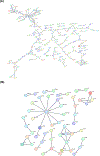Molecular targets of PXR-dependent ethanol-induced hepatotoxicity in female mice
- PMID: 38986717
- PMCID: PMC11410527
- DOI: 10.1016/j.bcp.2024.116416
Molecular targets of PXR-dependent ethanol-induced hepatotoxicity in female mice
Abstract
The pregnane X receptor (PXR, NR1I2), a xenobiotic-sensing nuclear receptor signaling potentiates ethanol (EtOH)-induced hepatotoxicity in male mice, however, how PXR signaling modulates EtOH-induced hepatotoxicity in female mice is unknown. Wild type (WT) and Pxr-null mice received 5 % EtOH-containing diets or paired-fed control diets for 8 weeks followed by assessment of liver injury, EtOH elimination rates, histology, and changes in gene and protein expression; microarray and bioinformatic analyses were also employed to identify PXR targets in chronic EtOH-induced hepatotoxicity. In WT females, EtOH ingestion significantly increased serum ethanol and alanine aminotransferase (ALT) levels, hepatic Pxr mRNA, constitutive androstane receptor activation, Cyp2b10 mRNA and protein, oxidative stress, endoplasmic stress (phospho-elF2α) and pro-apoptotic (Bax) protein expression. Unexpectedly, EtOH-fed female Pxr-null mice displayed increased EtOH elimination and elevated levels of hepatic acetaldehyde detoxifying aldehyde dehydrogenase 1a1 (Aldh1a1) mRNA and protein, EtOH-metabolizing alcohol dehydrogenase 1 (ADH1), and lipid suppressing microsomal triglyceride transport protein (MTP) protein, aldo-keto reductase 1b7 (Akr1b7) and Cyp2a5 mRNA, but suppressed CYP2B10 protein levels, with evidence of protection against chronic EtOH-induced oxidative stress and hepatotoxicity. While liver injury was not different between the two WT sexes, female sex may suppress EtOH-induced macrovesicular steatosis in the liver. Several genes and pathways important in retinol and steroid hormone biosynthesis, chemical carcinogenesis, and arachidonic acid metabolism were upregulated by EtOH in a PXR-dependent manner in both sexes. Together, these data establish that female Pxr-null mice are resistant to chronic EtOH-induced hepatotoxicity and unravel the PXR-dependent and -independent mechanisms that contribute to EtOH-induced hepatotoxicity.
Keywords: Alcohol; Ethanol; Nuclear receptors; Pregnane X receptor; Sex differences; Steatosis.
Copyright © 2024 Elsevier Inc. All rights reserved.
Conflict of interest statement
Declaration of competing interest The authors declare that they have no known competing financial interests or personal relationships that could have appeared to influence the work reported in this paper.
Figures










References
Publication types
MeSH terms
Substances
Grants and funding
LinkOut - more resources
Full Text Sources
Research Materials
Miscellaneous

